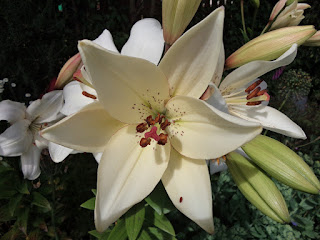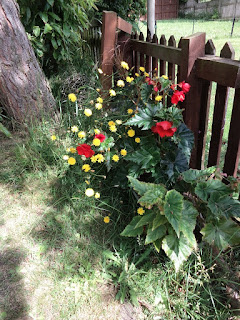To be a flower, a fruit or a seed? That is the question. Or at least I used to think that was the question.
To be a flower? And if a flower, then what kind of flower?
Corn Poppy dropping its head in the rain:
Papaver rhoeas.
Cobweb House Leek so called because of the apparent web on the foliage:
Sempervivium arachnoideum 'Rubrum'.
What you may think is the flower here is not - the flowers are those tiny things in the middle - hundreds of them. This is a form of Fleabane:
Erigeron.
This flower is so torn it is actually called Ragged Robin:
Lychnis flos-cuculi. It has hitched a lift here in a pot of Red Campion - not entirely sure how as it usually likes damp places - maybe the drainage in this pot isn't up to much.
A single rose -
Rosa - : single meaning it has only the one set of petals as opposed to the more common garden rose which has rows and rows of petals. Bees like these while the other roses are pretty useless from their point of view.
This is what remains of the sumptuous and scented red
Rosa 'Etoile d'Hollande' whose picture I posted back in June - has it been pollinated? I'd be surprised really, but is that a fruit forming?
The spectacular trumpets of the Asiatic Lily -
Lilium 'Blackout'.
The simple yet exquisite beauty of our native Meadow Cranesbill -
Geranium pratense - flowering for the first time in this garden.
One of the first flowers whose form caught my imagination as an adult years ago when I knew even less than I do now, this is
Fuchsia magellanica - delicate and exotic-looking but tough as old nails (although I have often found rusty old nails to be a bit fragile I assume the makers of traditional similes knew what they were doing).
Yellow florets of
Hieracium pilosella while the first red flowers of the tuberous
Begonia are appearing - the latter are in a container as I think it would be tricky to get these two plants to grow happily alongside each other in the ground.
More florets - this time the orange of Fox and Cubs -
Pilosella aurantiaca - and of course, those grasses are in flower as is the Red Campion -
Silene dioica.
Is this grass in flower or is it in seed? I think it is both, maybe: Greater Quaking Grass -
Briza maxima.
Urtica dioica - stinging nettle - just lets its flowers dangle while sending vigorous rhizomes underground - so does it really need the flowers? Well they help sustain genetic diversity in the species thus improving its survivability - a good argument against racism as well, by the way.
Honeysuckle - in this case it is
Lonicera periclymenum 'Graham Thomas'.
Some flowers look like they were made for bees - or were bees made for them? A white Foxglove -
Digitalis purpurea f. albiflora. The answer, of course, is that they both evolved - but how?
The Maiden Pink -
Dianthus deltoides - is the plant dominating this picture - called Pink not because of its colour but because of the pinking around the edge of its petals as if they had been trimmed with pinking shears.
And finally, florally speaking, a carpet of Creeping Red Thyme developing -
Thymus coccineus, although I also have it listed as
Thymus serpyllum 'Coccineus'. So, which is the correct name? I don't know, but either way don't let anyone steal it ....
To be a fruit? And if a fruit, then what kind of fruit?
A Blueberry with fruits swollen waiting to turn purple - last year the blackbirds enjoyed these:
Vaccinium corymbosum 'Patriot'.
But the Blackbirds aren't getting my strawberries -
Fragaria - hence the netting. They are slowly turning beautifully red and the botanists tell me they aren't really berries at all - but they
are a fruit.
A flower that will be a fruit full of seeds: Bramble, or Blackberry -
Ribes spp. - growing up through one of the Yew trees.
Fruit or seed? Or both? Peony Rose,
Paeonia, looks prehistoric to my eye and just a little bit scary.
To be a seed? And if a seed, then what seed?
Seeds of the Snake's Head Fritillary -
Fritillaria meleagris. I collected these after taking this picture and will have a bash at growing some from seed - patience will be required.
On the plant you more often see the case that contains the seed (that would be a fruit, or a nut or whatever...).
Poppy - in this instance it is the orange Spanish Poppy-
Papaver rupifragum. Very pretty with its little windows at the top of the capsule through which the ripe seed will spill on a suitably windy day.
Poppy too and yet it manages to be both very different and very similar to the Spanish Poppy at the same time. This is the Welsh Poppy (flower in the background) -
Meconopsis cambrica.
Another little capsule full of seeds, this time on Red Campion -
Silene dioica - no windows this time, just an open roof.
Some like Columbine -
Aquilegia vulgaris - make fancy little ships with their seed pods. These belong to a huge family called Ranunculaceae and many of its members make a similar shape e.g
Delphinium,
Nigella and even
Helleborus. I'd show you if I could but the Delphiniums are still in flower - although I think I have a Hellebore.
Ach, too late - the seeds from this Hellebore or Lenten Rose -
Helleborus orientalis hybrid possibly - have long gone, but maybe you can still get a sense of what I mean.
Some seeds will just drop to the ground as they ripen: Windflower -
Anemone blanda 'Blue Shades'.
While some seeds grow wings and fly - this is a cheat as this tree grows in my neighbour's garden but it largely overhangs mine so I feel I belong to it too. It's a Maple -
Acer - of some kind, but I don't know which. Both flowers and seeds have a lovely crimson tinge and the leaves are clean of black spot unlike my Sycamore -
Acer pseudoplatanus.
Honesty,
Lunaria annua, has this attractive seedhead - the outer covering will peel off in time revealing the silver coins that I presume gave this its common name and certainly its generic name.
So which is to be? Flower, Fruit or Seed? Well, I've decided it doesn't matter. There's more to life than worrying about what stage I am at and while wise men can draw botanical distinctions in real life the boundaries are often very blurred - often it depends on your point of view. They key for me is to try and savour whatever stage I am at and while looking at the detail is fascinating it is also good to keep my eye on the big pictures:
Of course, sometimes the big picture can look a mess but it's my mess and I am very grateful for it.



























































